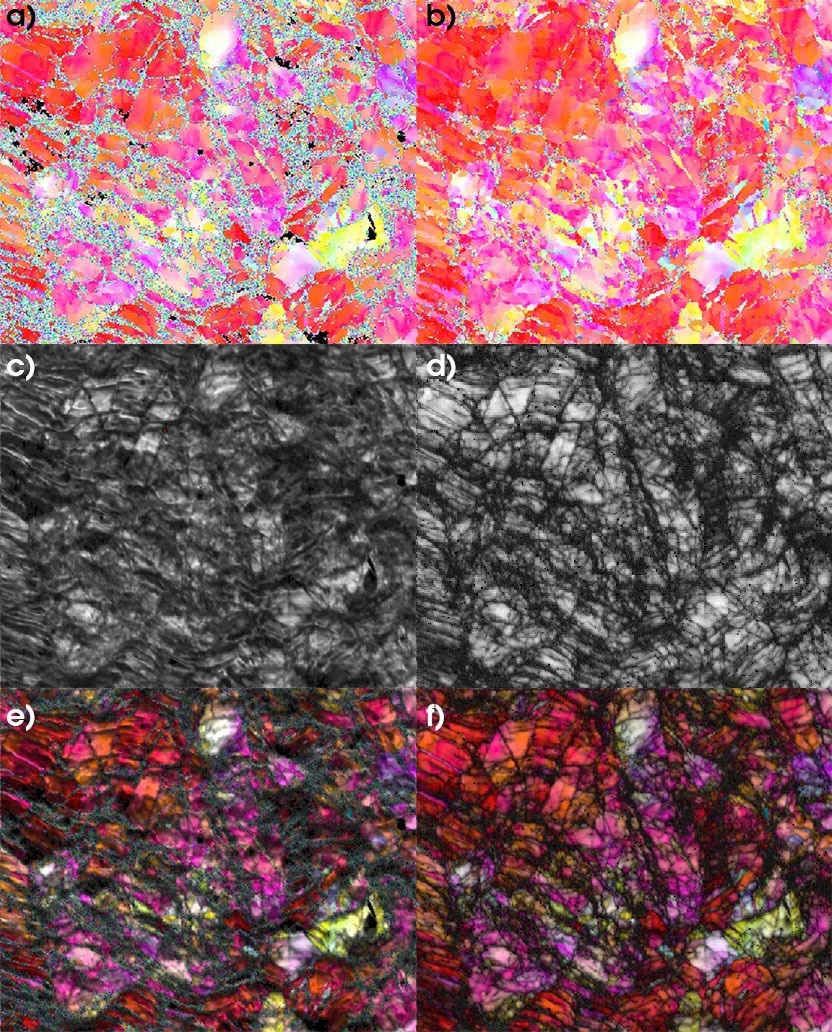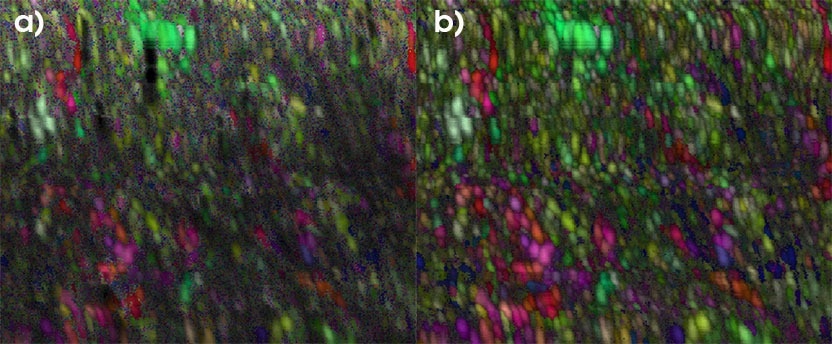Sponsored by Gatan, Inc.Reviewed by Olivia FrostFeb 15 2023
Dictionary indexing compares experimental electron backscatter diffraction (EBSD) images to a dictionary of generated patterns in oriented space for each orientation on a uniform grid.1,2
The experimental geometry is used to make synthetic patterns by rotating the Kikuchi sphere by the crystallographic orientation and projecting it onto a plane. When compared to a physics-based forward model, it provides great accuracy and noise tolerance at the expense of substantial processing overhead.
The same Kikuchi sphere or 'master pattern' is used in spherical harmonic indexing, but experimental patterns are back-projected onto the sphere instead. The highest spherical cross-correlation between the back-projected image and the Kikuchi sphere is used to index the orientation.3,4
Dictionary and sphere indexing are quite similar mathematically, but the spherical method is more numerically efficient since it can use quick Fourier transformations for the calculations. In reality, spherical indexing has the same accuracy5 and noise tolerance as dictionary indexing, but at substantially quicker rates.
A GPU implementation of spherical harmonic-based EBSD indexing in OIM AnalysisTM as part of the OIM MatrixTM module delivers high-quality indexing at hundreds or thousands of patterns per second. This study used it on a variety of scans to illustrate indexing quality and user settings.
The bandwidth and grid size are two important factors of spherical harmonic indexing. The bandwidth specifies how far space harmonics are computed in frequency (analogous to a low pass filter on the EBSD pattern).
The correlation resolution is defined as an Euler angle cube of (grid size)3 utilized for correlation (e.g., 0 – 360 for phi1, Phi, and phi2). Computation time generally tends to increase with the number of Euler angle grid points, and an acceptable bandwidth is less than half the grid size.
Below are some examples of appropriate pairings of values:
Source: EDAX
| Bandwidth |
Grid Size |
| 63 |
128 |
| 95 |
192 |
| 127 |
256 |
After selecting the optimum Euler grid point (with the highest cross-correlation), a refining step may be used to attain subpixel resolution.
Examples
Ni Sequence
Spherical indexing may be used for EBSD patterns of varying quality. In this example, scans of the same location on a well-polished nickel alloy were acquired at various camera gains to create equivalent sets of poor and high-quality patterns with changing pattern signal-to-noise ratios (SNR).
Spherical indexing was then done and compared to normal Hough-based indexing to show how spherical indexing can better index patterns with lower SNR values and provide higher-quality data than traditional indexing.

Figure 1. Shows a) the result of indexing high-quality patterns, b) spherical harmonic indexing at a bandwidth of 63 and Euler grid of 1283 without refinement, and c) at a bandwidth of 63 with refinement. Image Credit: EDAX.
Figure 1 depicts a) the outcome of indexing high SNR sequences, b) spherical harmonic indexing at a bandwidth of 63 and Euler grid of 1283 without refinements, and c) spherical harmonic indexing at a bandwidth of 63 with refinement.
It is important to note that since grid point spacing is ~2.8° (360° / 128), the unrefined result has a stepped appearance due to the discrete orientation possibilities. Any orientation is conceivable after refining, resulting in smooth results.

Figure 2. KAM maps are shown for the same region at a) 0°, b) 1°, and c) 2°. Image Credit: EDAX.
Figure 2 depicts KAM maps for the same location at a) 0°, b) 1°, and c) 2°. One major takeaway from this is that without refinement, it is apparent that there is no misorientation within a patch and a sharp spike between them.
Even though both the Hough and refined spherical seem smooth, KAM reveals some orientation noise in the Hough indexing.

Figure 3. With low-quality patterns, Hough indexing a) starts to fail, but b) spherical indexing still provides robust solutions and c) accurately captures continuous orientation gradients after refinement. Image Credit: EDAX.
With low SNR patterns, Hough indexing a) begins to fail with low SNR patterns, whereas b) spherical indexing still yields stable solutions and c) correctly captures continuous orientation gradients after refining (Figure 3).

Figure 4. a) bandwidths of 63, b) 95, and c) 127 are compared before (a – c) and after (d – f) refinement. Image Credit: EDAX.
Higher bandwidths may be necessary for better indexing results with extremely low SNR patterns. Figure 4 compares bandwidths of 63, 95, and 127 before (a-c) and after (d - f) refining.
It is worth noting that the discrete steps in orientations before refinement grow smaller as the Euler angle grid resolution increases, yet they refine to comparable orientations. The grid size is 2 * (bandwidth + 1) for all three bandwidths.

Figure 5. a) Raw pattern and b) NPAR pattern using Hough indexing and c) raw pattern and d) NPAR pattern using spherical indexing with a bandwidth of 127. Image Credit: EDAX.
Existing image processing methods may be utilized for particularly complex patterns with spherical indexing incorporated into OIM Analysis. At extremely high noise levels, Hough indexing is unable to index any points, and the spherical indexing begins to fail for some points.
By averaging each pattern with its neighbors, NPAR compromises spatial resolution for pattern quality. Both approaches can correctly index the enhanced patterns, although Hough indexing suffers from the ensuing overlap trends near grain boundaries (Figure 5).
Hot Rolled Mg

Figure 6. Hough indexing struggles to index when pattern quality is reduced by a) high deformation, but b) spherical indexing is robust against significantly degraded pattern quality. Note that the d) spherical indexing confidence index strongly correlates with c) image quality but is high even in some regions with extremely low IQ. Image Credit: EDAX.
Magnesium can be a challenging material to analyze using EBSD as it is a light element with a smaller backscatter signal, which results in lower SNR values for EBSD patterns.
This difficulty is exacerbated when the magnesium sample is bent since the resulting lattice distortion reduces the overall pattern quality.
Hough indexing finds it challenging to index these types of patterns (a), but spherical indexing is robust against degraded pattern quality (b), allowing better indexing as deformation levels increase.
It is worth noting that the d) spherical indexing confidence index substantially corresponds with c) image quality, although it is also high in certain locations with very low IQ (Figure 6).
Deformed Duplex Steel

Figure 7. Phase discrimination depends on the similarity of the phases with a two-phase steel. In addition to the quality in orientation results with d – f) spherical indexing vs. a – c) Hough indexing, b – c & e – f) phase discrimination is improved with spherical BCC and FCC iron well separable. Image Credit: EDAX.
The preceding examples demonstrated how spherical indexing could enhance EBSD pattern indexing when EBSD pattern quality deteriorates owing to lower SNR values or increasing sample deformation.
In this example, spherical indexing of a distorted multiphase sample is utilized to demonstrate how indexing gains may be accomplished even when many phases are included. Spherical indexing, like any other indexing method, may be used in several phases.
Phase discrimination depends on the similarity of the phases with a two-phase steel shown in Figure 7.
In addition to the quality in orientation results with d – f) spherical indexing vs. a – c) Hough indexing, b – c & e – f) phase discrimination is improved with spherical BCC and FCC iron well separable.
Real space refinement, in addition to the spherical harmonic refinement illustrated, may be necessary for exceptionally complex applications.

Figure 8. a) spherical CI + IPF shows similar trends as b) Hough IQ + IPF. Image Credit: EDAX.
The confidence index of spherical indexing corresponds highly with pattern quality. Figure 8 indicates that a) spherical CI + IPF exhibits comparable tendencies to b) Hough IQ + IPF.
Conclusion
Forward model indexing helps users to get the most information from their data, but it had a high learning curve in the past. Although Hough indexing is well established, it remains susceptible to poor pattern quality.
Spherical harmonic-based indexing combines the robustness of forward model indexing with the speed and ease of use of Hough indexing.
References
- Callahan, P. G., & De Graef, M. (2013). Dynamical electron backscatter diffraction patterns. Part I: Pattern simulations. Microscopy and Microanalysis, 19(5), 1255-1265.
- Callahan, P. G., & De Graef, M. (2013). Dynamical electron backscatter diffraction patterns. Part I: Pattern simulations. Microscopy and Microanalysis, 19(5), 1255-1265.
- Lenthe, W. C., Singh, S., & De Graef, M. (2019). A spherical harmonic transform approach to the indexing of electron backscattered diffraction patterns. Ultramicroscopy, 207, 112841.
- Hielscher, R., Bartel, F., & Britton, T. B. (2019). Gazing at crystal balls: Electron backscatter diffraction pattern analysis and cross-correlation on the sphere. Ultramicroscopy, 207, 112836.
- Sparks, G., Shade, P. A., Uchic, M. D., Niezgoda, S. R., Mills, M. J., & Obstalecki, M. (2021). High-precision orientation mapping from spherical harmonic transform indexing of electron backscatter diffraction patterns. Ultramicroscopy, 222, 113187.

This information has been sourced, reviewed and adapted from materials provided by Gatan Inc.
For more information on this source, please visit Gatan Inc.